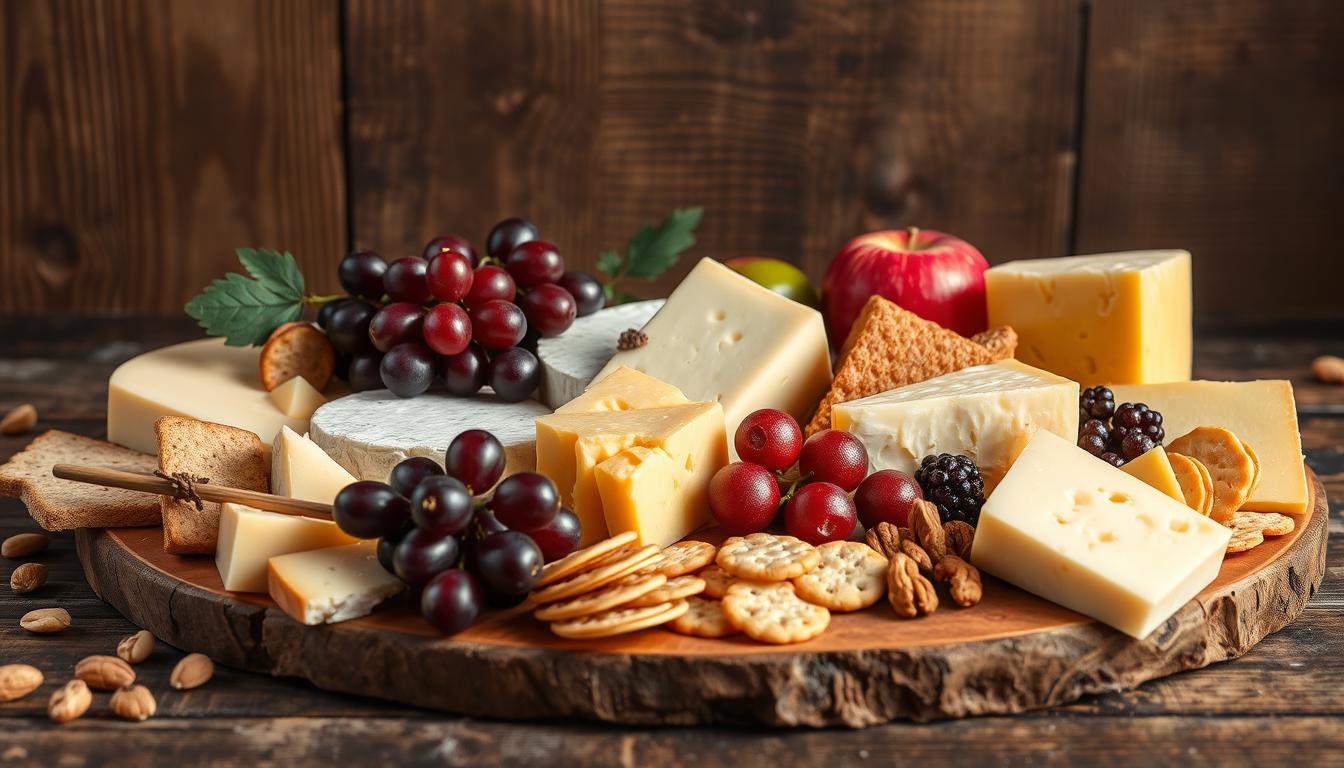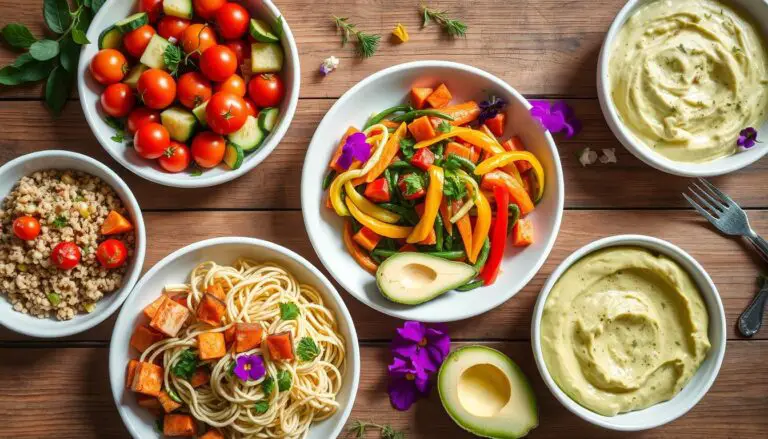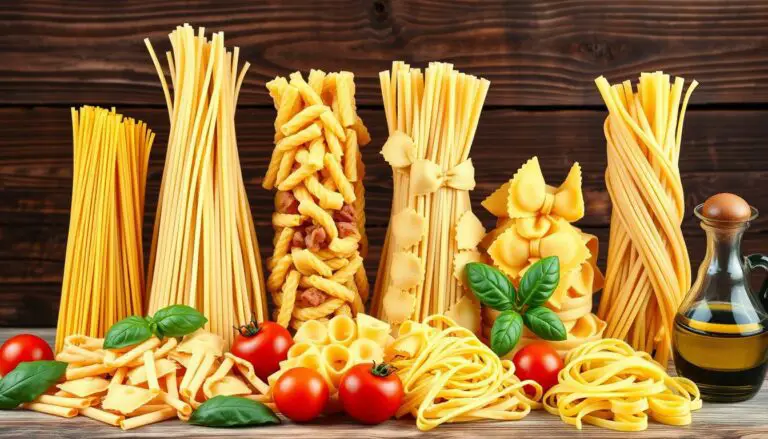Cheddar Cheese Facts, Types, and Pairing Guide
Cheddar cheese has been loved for over 800 years, starting in the 12th century. It comes from Cheddar, England, and is now a favorite around the world. It’s known for its rich taste and many uses.
There are many types of cheddar, like mild, medium, sharp, and aged. This means it suits many tastes and recipes. Whether you enjoy it alone or in fancy dishes, cheddar is key. This guide will dive into its history, types, and how to pair it. For more, check out here1.
Key Takeaways
- Cheddar cheese has a history of over 800 years, originating in the 12th century.
- Vermont is renowned for producing some of the world’s best cheddar, according to Cabot Creamery.
- Cheddar cheese varies in types, including aged, sharp, and flavored varieties.
- It blends seamlessly with complementary flavors and works well in cheese pairings.
- Different styles of cheddar cheese can enhance various dishes, depending on their preparation method.
- Pairing cheddar with specific wines and beers can elevate the tasting experience.
- With its versatility, cheddar cheese is perfect for an array of recipes and uses.
History of Cheddar Cheese
The story of cheddar cheese begins in the 12th century in Cheddar, Somerset, England. It was first made by local farmers. A milkmaid accidentally made cheese by cooling milk in a cave. This event started cheddar’s journey to fame.
Cheddar cheese was loved for its long shelf life. This made it a favorite among the rich. It quickly became popular in England and beyond.
Origins in Cheddar, England
In 1170, Henry II bought 10,240 pounds of cheddar. He called it the best cheese in England2. The first cheese factory in upstate New York in 1851 helped spread cheddar worldwide2.
Cheddar cheese made its way to America. It thrived in places like Wisconsin, where it was made in huge amounts.
Evolution and Popularity Across the Globe
Cheddar cheese is loved in many countries. In the U.S., it’s the second-most popular cheese after mozzarella. Americans eat about 10 lb (4.5 kg) of cheddar each year3.
In 2014, the U.S. made about 3 billion lb (1,300,000 long tons; 1,400,000 tonnes) of cheddar3. Australia loves cheddar too, with 55% of its cheese market being cheddar3.
Types of Cheddar Cheese
Cheddar cheese comes in many flavors and textures. Knowing the difference between young and aged cheddar can make your cheese choices better. It also makes pairing cheese with food more fun.
Young vs. Aged Cheddar
Young cheddar is aged for 1 to 3 months. It has a mild, creamy taste that’s great with snacks and sandwiches. It melts well because it’s moist4.
Aged cheddar, aged 6 months to over 60 months, gets sharper and more complex. It becomes crumbly and can taste tangy, nutty, robust, or earthy5. Vintage cheddar is especially strong, perfect for bold foods.
Different Varieties of Cheddar
There’s a wide range of cheddar cheeses. Clothbound cheddar has a hard rind and complex taste. Waxed cheddar is buttery with milder, nutty flavors4. Vegan cheddar mimics sharp cheddar and melts well5.
To enjoy cheddar’s variety, pair mild cheeses with malbec or red zinfandel. Sharp cheeses go well with bold wines like Cabernet6.
| Type of Cheddar | Aging Period | Flavor Profile | Texture |
|---|---|---|---|
| Young Cheddar | 1 – 3 months | Mild and Creamy | High moisture, smooth |
| Medium Cheddar | 3 – 6 months | Slightly Tangy | Retains a smooth texture |
| Aged Cheddar | 6 – 12 months | Sharp and Robust | Hard, crumbly with crystals |
| Vintage Cheddar | 12 months and above | Complex, Nutty | Dry, flaky with pronounced crystals |
| Vegan Cheddar | Varies | Imitating Sharp Cheddar | Soft with good melting |
Exploring different cheddar cheeses can make cooking more exciting. For more on these cheeses and their origins, check out this guide4.
What Makes Cheddar Cheese Unique?
Cheddar cheese is known for its unique cheddar cheese flavors, cheddar cheese aromas, and cheddar cheese textures. Its history began in the 12th century in England7. Young cheddar is creamy and buttery, with mild flavors. Aged cheddar is firmer, with a nutty taste and salt crystals7.
Flavor Profiles and Textures
Cheddar cheese comes in different textures and flavors. The aging process adds distinct tastes, thanks to specific bacteria like Lactococcus cremoris8. This bacteria adds fruity and meaty notes. Traditional English Cheddars have tangy undertones, influenced by terroir and cheesemaker techniques9.
Visual and Aromatic Qualities of Cheddar
Cheddar cheese has a unique look, from pale white to vibrant orange. The orange color comes from annatto7. Young cheddar smells creamy, while aged cheddar has a richer, earthier scent8. This variety makes cheddar great for many dishes, from snacks to main courses explore different styles of cheddar cheese.
| Cheddar Type | Texture | Flavor Profile | Aroma |
|---|---|---|---|
| Young Cheddar | Smooth and buttery | Mild and creamy | Light and mild |
| Aged Cheddar | Firm and granular | Sharp and nutty | Rich and earthy |
| Traditional English Cheddar | Varies, often crumbly | Tangy with seasonal variations | Complex and robust |
The mix of cheddar cheese textures and cheddar cheese aromas makes cheddar special. It has a lasting appeal in food, offering a great taste experience.
Cheddar Cheese Nutrition
Cheddar cheese is loved for its taste and nutritional value. It’s packed with protein, which is great for muscle growth. One ounce has about 6.5 grams of protein, or 13% of your daily needs. It also has 16% of the daily calcium, important for strong bones10.
It’s a good source of vitamins A and B12, too. These vitamins are worth 11% and 13% of your daily intake, respectively10.
Health Benefits of Cheddar Cheese
Eating cheddar cheese in moderation has many health benefits. It can help lower cholesterol in middle-aged adults, better than reduced-fat cheese or butter11. A small piece of cheddar has 69 calories and some saturated fat, but it’s okay in a balanced diet10.
Nutritional Breakdown and Serving Suggestions
Cheddar cheese has a unique nutritional profile. Each ounce has 185.5mg of sodium and 28.1mg of cholesterol10. It’s key to control your portions.
Choosing sharper cheddar can make your snacks more flavorful. Swapping sugary snacks for cheddar can also help prevent cavities11.
Pairing Guide for Cheddar Cheese
Choosing the right drinks to go with cheddar cheese is key to bringing out its best flavors. Knowing how to pair wine and beer with cheddar can make any meal special. The right match can turn a simple dish into a feast for the senses.
Wine Pairings with Cheddar
Not all wines are good with cheddar. Light white wines, like Riesling, go well with young cheddar, offering a nice balance. For sharper cheddars, full-bodied reds like Cabernet Sauvignon are perfect. It’s important to avoid mixing foods with high acidity with bitter wines for the best taste12.
A good wine pairing can blend different tastes and textures beautifully.
Beer Pairings with Cheddar
Cheddar cheese is amazing with the right beers, bringing out its rich flavors. Milder beers work well with young cheddars, while hoppy IPAs bring out the boldness of extra sharp cheddars. It’s smart to pair lighter beers with milder cheeses to keep the flavors balanced13.
For example, Vermont Sharp Cheddar is great with Lager, and Extra Sharp Cheddar pairs well with Pale Ale. Exploring different beer pairing cheddar cheese options can lead to exciting discoveries and enjoyable taste adventures.
| Cheddar Type | Recommended Wine | Recommended Beer |
|---|---|---|
| Young Cheddar | Riesling | Mild Lager |
| Sharp Cheddar | Merlot | Pale Ale |
| Extra Sharp Cheddar | Cabernet Sauvignon | IPA |
| Farmhouse Reserve Cheddar | Chardonnay | Brown Ale |
Cheddar Cheese Recipes
Cheddar cheese is a great ingredient for many dishes. It can make any meal special, from macaroni and cheese to cheddar-infused cornbread. Cooking with cheddar cheese brings out both classic and new flavors.

Using Cheddar in Cooking
Cheddar adds flavor to many dishes. For example, Cheddar-Scallion Biscuits have a lot of grated sharp cheddar for a strong taste14. Beer and Cheddar Soup combines sharp yellow and smoked cheddar for a rich flavor14.
Cheddar Rillettes use bacon fat for a rich appetizer14. Cheddar-Stuffed Burgers have extra-sharp cheddar inside for a gooey center14.
Creative Ways to Enjoy Cheddar
Cheddar inspires many creative cheddar recipes. Smoked Cheese Cocktail Cookies mix sharp cheddar and smoked Gouda for a tasty snack14. The New American Grilled Cheese uses extra-sharp shredded cheddar with Monterey Jack for a gourmet touch14.
Cheddar Cheese Pound Cake is a sweet surprise with mellow cheddar in the batter14. Buttermilk Macaroni and Cheese uses a lot of cheddar and baby kale for a filling meal14.
| Recipe Name | Main Ingredients | Cooking Method | Preparation Time |
|---|---|---|---|
| Cheddar-Scallion Biscuits | Grated sharp cheddar, scallions | Baking | 30 minutes |
| Beer and Cheddar Soup | Sharp yellow cheddar, smoked cheddar | Stove-top | 45 minutes |
| Cheddar Rillettes | Rendered bacon fat, cheddar | Chilling | 60 minutes |
| Cheddar-Stuffed Burgers | Extra-sharp cheddar, ground beef | Grilling | 30 minutes |
| Smoked Cheese Cocktail Cookies | Sharp cheddar, smoked Gouda | Baking | 40 minutes |
| Cheddar Cheese Pound Cake | Mellow cheddar, flour | Baking | 50 minutes |
| Buttermilk Macaroni and Cheese | Cheddar, baby kale | Baking | 40 minutes |
How is Cheddar Cheese Made?
The making of cheddar cheese is a detailed process. It starts with heating fresh milk and adding special cultures. These cultures make the milk turn into curds, a key step in making cheddar.
The Cheese-Making Process
After the milk turns into curds, they are cut into small pieces. This helps remove extra moisture. The curds are then cooked until they become firm.
The cheddaring process is what makes cheddar cheese special. It involves stacking and turning the curds. This step removes more moisture and adds to the cheese’s flavor and texture, making it uniquely cheddar1516.
Modern Techniques in Cheddar Production
Modern methods have changed cheese-making for the better. New tools help make cheddar cheese consistently high quality. Techniques like vacuum sealing keep the cheese fresh for longer.
Wisconsin is a big player in cheddar cheese, producing enough to match the UK. They’ve won over 5,500 cheese awards, more than any other place in the world1516.
| Cheddar Type | Typical Aging Period | Flavor Profile |
|---|---|---|
| Mild Cheddar | 3 to 6 months | Soft, creamy |
| Sharp Cheddar | 6 to 12 months | Pungent, tangy |
| Extra Sharp Cheddar | 12 to 18 months and beyond | Strong, bold |
Popular Cheddar Cheese Brands
Cheddar cheese is loved all over the world, especially in the U.S. and U.K. Many best cheddar cheese brands have made a name for themselves. They offer top-notch cheddar that cheese fans adore. Companies like Cabot Creamery are known for their Vermont Cheddar, winning many awards for its quality.
Recognized and Award-Winning Brands
When it comes to cheddar cheese, ratings show what people and experts like. For example, Trader Joe’s Unexpected Cheddar got a high 9.5/10 for being versatile. Kerrygold Reserve scored 9/10, perfect for a cheese board17. Tillamook Extra Sharp White Cheddar was a hit for grilled cheese, getting 9/1017.
Old Croc Sharp Cheddar is the top pick, with a 10/10 rating17.
Craft Cheddar Cheese Producers
Craft cheddar cheese makers are adding variety to the market. They focus on unique flavors, using local dairy methods. These brands offer a range of ages, from mild to extra sharp, with rich flavors.

Cheddar’s taste is unique, making it great for many dishes. Recent blind taste tests showed that cheddars with nutty flavors and good meltability are the best18. Exploring craft cheddar lets cheese enthusiasts enjoy the artistry of small producers.
Conclusion
Cheddar cheese has been loved for over 800 years. It started in Somerset, England, and now we have many types worldwide19. Exploring different cheddars can make enjoying cheese even better, whether in recipes or with drinks20.
With a guide to cheddar, we see its many uses and health benefits. It has about 6 grams of protein per slice and is healthier than processed cheeses like American21. As new cheddars come out and old methods are brought back, we get to try even more tasty things19.
Discovering cheddar cheese makes our food experiences richer. It connects us to a big part of global food culture. Learning about cheddar in all its forms sparks creativity and deepens our respect for its long history20.







